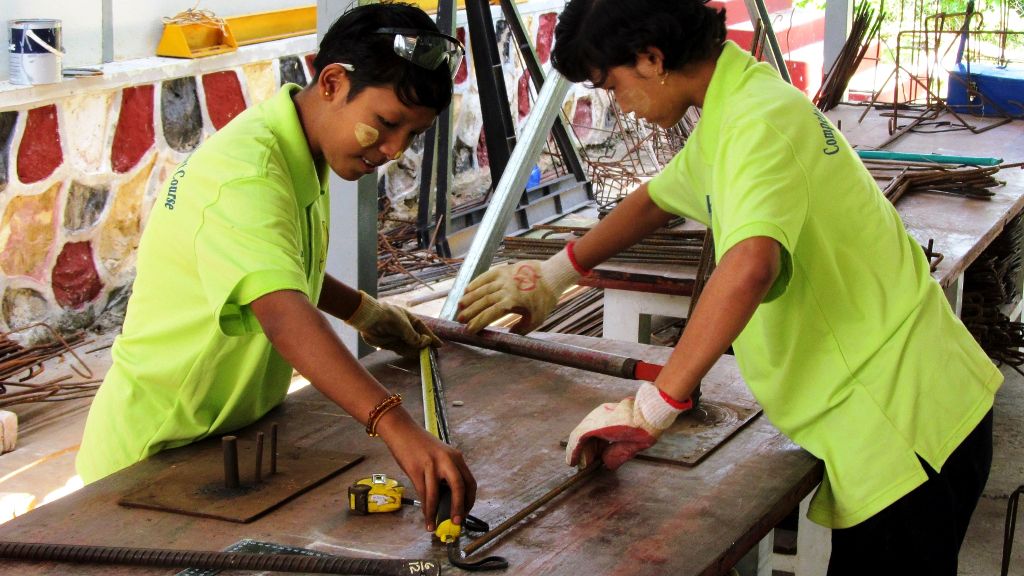Context: Youth (those aged 15–29) make up roughly a quarter of Myanmar’s population. This age group is essential for Myanmar’s future, yet many young people lack access to quality education. In 2016, the Myanmar youth literacy rate was 84.8 per cent, far lower than neighbouring countries. A UNICEF labour force survey conducted in 2015 found that 60 per cent of underage workers were girls, and around 30 per cent of students dropped out from school by the age of 17. Furthermore, industrial skills training is very low in rural communities, so a large proportion of young work in low skilled jobs.
Implementation of programme/ initiative: In 2016, the Myanmar Government began implementing the Equipping Youth for Employment Project. This aims to strengthen the education and skills base of youth of the country, assist in the transition toward a modern economy, and promote job creation. In particular, it plans to advance national reforms of the secondary education sub-sector and vocational education, to effectively meet Myanmar’s evolving needs. In November 2016, the Asian Development Bank (ADB) provided initial funding of USD98 million to the project. In 2019, the European Union announced that they were granting USD26 million in the form of technical assistance. These funds are being used to build 48 new vocational schools, stocked with modern equipment and up-to-date educational materials. Funds are also going towards training 90,000 teachers, of which 63,000 are female. The remainder of the funds are to be used to support poverty-stricken students (which make up roughly a third of the total student population); they are to be exempted from having to pay dorm fees and are to receive a monthly stipend of MMK40,000 (USD30) per person. The project requires that at least 50 per cent of beneficiaries are to be female and that 80 per cent are to be ethnic group trainees from rural areas. The main target group of the project are youth who are 16–23 years old and have dropped out of school before completion of Grade 9. The Government expects 550,000 male students and 550,000 female students to study under the new curricula and graduate by the end of 2023.
Main challenges: In Myanmar, the Government recognizes 135 different ethnic groups, each with their own specific history, culture and language. Although the Government encourages more ethnic minorities to join the project by proving free education and stipends, many minority groups are concerned that the centralized teaching may assimilate their own cultures, or that they may face discrimination based on ethnicity and gender. People living in remote areas may have less interest in modern skills training and many parents prefer to have their children stay home and help with family work. Moreover, since the project has a large amount of funds and capital flows, complete transparency is very important. It is a challenge for the Myanmar Government to ensure that all funds are used efficiently in the designed places.
Results achieved: According to ADB, as of September 2020, the status of implementation was satisfactory with regard to social and economic indicators. Some goals have already been exceeded. Around 157,000 teachers, 141,000 of whom female, finished their first annual round of training. Furthermore, 45 new vocational schools located in different regions have been under construction, and 15 of them are near completion. In addition, the project has assisted the Ministry of Education to prepare textbooks and teaching guides for Grade 7 to 10. The improved textbooks and pedagogy have benefitted approximately 910,000 students in terms of enhanced learning.
Moving Forward: Although the current project focuses primarily on secondary and vocational education, higher education is also very important for Myanmar’s development. In 2020, there were around 910,000 high school graduates in Myanmar, but only 32 per cent of them passed the college entrance examination. Although there is a need for highly-skilled workers, many college graduates still choose to migrate abroad in the pursuit of higher education and better careers. Therefore, the Government would benefit from implementing a further project to enhance the outcomes of university education. Relatedly, a greater budgetary allocation to the education sector is warranted, especially since, in 2019, the Myanmar Government disbursed 8.8 per cent of total Government funds to this sector, one of the lowest education budgets in the ASEAN region.
Replicability: Although this project primarily aims to train and educate youth, it also creates many job opportunities for construction workers, civil servants and teachers, which, in turn, stimulates domestic economic development. The project has identified disadvantages of Myanmar’s traditional education system, and reformed the curriculum to adapt to the needs of a modern nation. Under the new curriculum, education has become more engaging and beneficial to students, and it also promotes equality of gender and ethnicity. Many developing countries can replicate this project to assist in getting their education systems modernized and to generate jobs, or to rework their education systems in a way that promotes greater equality.
Acknowledgement:
This good practice was kindly prepared by Ms. Juanying Xie.
References:
https://www.mmtimes.com/news/us26-million-grant-set-boost-local-education.html
https://data.worldbank.org/indicator/SE.ADT.1524.LT.ZS?locations=MM
Project Details
Date: January 29, 2021
